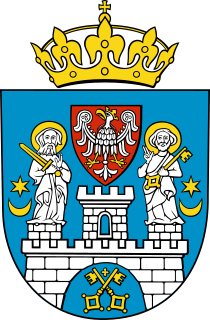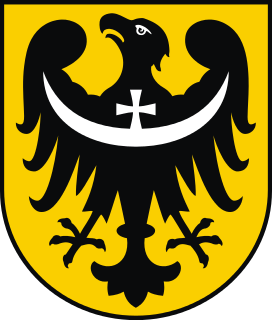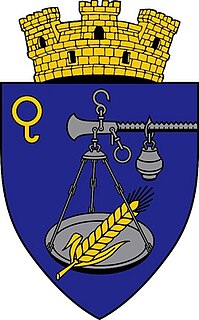
The national flag of Romania is a tricolor. The Constitution of Romania states that "The flag of Romania is tricolor; the colors are arranged vertically in the following order from the flagpole: blue, yellow, red". The flag has a width-length ratio of 2:3; the proportions, shades of color as well as the flag protocol were established by law in 1994, and extended in 2001.

The flag of Poland consists of two horizontal stripes of equal width, the upper one white and the lower one red. The two colours are defined in the Polish constitution as the national colours. A variant of the flag with the national coat of arms in the middle of the white fess is legally reserved for official use abroad and at sea. A similar flag with the addition of a white eagle is used as the naval ensign of Poland.

The coat of arms of Poland is a white, crowned eagle with a golden beak and talons, on a red background.

The city of Kraków uses a coat of arms, a seal, official colors, a flag, and a banner as its official symbols. Additionally, a number of semi-official and unofficial symbols of the city are also used.

The coat of arms of Poznań consists of white city walls with three towers. On the left (heraldic) tower stands Saint Peter with a key and on the heraldic right one stands Saint Paul with a sword. In the gate there are two golden crossed keys with a cross above. Over the middle tower, which contains a single window and is topped by a battlement, there is a gothic shield with a white eagle in crown. On the sides of the two saints there are golden crescents and stars. All of those elements are on a blue field. Over the shield there is golden crown. Author of modern version of coat of arms is Jerzy Bąk.

The coat of arms of Kłodzko shows a white Bohemian Lion on a red field with a golden crown and a double tail. The coat of arms comes from the dynasty of Czech kings Premyslids.

The coat of arms of Głogów depicts a shield divided crosswise into four fields, with a fifth central field on which there appears in the centre an initial golden "G" on a red background.

The original coat of arms of Ustka, Poland was created in 1922 by local artist Wilhelm Granzow.

Jack of the President of the Republic of Poland – Commander-in-Chief of the Armed Forces of the Republic of Poland is a jack flag used in the Polish Armed Forces to mark the presence and pay respect to the President of the Republic of Poland who is also ex officio the commander-in-chief of the Armed Forces. The jack is raised on Polish Navy ships when the president is officially on board, as well as on land, if the president is present. The design of the jack is based directly on the pre-war Banner of the Republic of Poland which used to be part of presidential insignia.

Kur is a Polish coat of arms. It was used by several noble families forming a Clan of Kur in the times of the Kingdom of Poland and the Polish–Lithuanian Commonwealth. It is noted during the reign of the Jagiellon dynasty and illustrated with its original name in the work of Bartosz Paprocki "Herby Rycerstwa Polskiego" in 1584. Furthermore, it is published in the work of Szymon Okolski in 1641. and several other publications
Białystok, like other major cities in Poland, is a city county. The Legislative power in the city is vested in the unicameral Białystok City Council, which has 28 members. Council members are elected directly every four years, one of whom is the mayor, or President of Białystok. Like most legislative bodies, the City Council divides itself into committees which have the oversight of various functions of the city government. Bills passed by a simple majority are sent to the mayor, who may sign them into law. If the mayor vetoes a bill, the Council has 30 days to override the veto by a two-thirds majority vote. The current President of Białystok, elected for his first term in 2006, is Tadeusz Truskolaski.

Coat of arms of Riga is one of the official symbols of Riga, along with the flag of Riga.

The coat of arms of the city of Gdańsk, in its current form, dates back to 1410 and Banderia Prutenorum. The coat of arms is very similar to the flag of Gdańsk. It depicts two silver crosses on a red shield above each other, above which hovers a golden crown. The greater arms also has two lions as supporters and Gdańsk motto.

The flag of Poznań is a rectangular piece of white material with the coat of arms of the city placed in the middle. It was adopted in 1997.

The coat of arms of the West Pomeranian Voivodeship is one of the symbols of the West Pomeranian Voivodeship, an administrative unit of Poland.

The coat of arms of Lower Silesia, and simultaneously of Silesia, shows a black eagle with silver crescent with cross in the middle on its chest on a golden background. It has been assumed in the tradition that the coat of arms and colors of Lower Silesia are simultaneously used as symbols of Silesia as a whole.

The coat of arms of Cimișlia is the official coat of arms of the city of Cimișlia, in the Cimișlia District, Moldova. It consists of a silver balance coming out of the coat of arms on the left and that holds an ear of grain representing the wealth of the city's cereals. On the canton (corner) of the coat of arms is the danga of a Tatar tribe, a unique symbol of Cimișlia. The field is blue, representing the sky and other values and elements. Above the coat of arms is a mural crown with three towers. It was proposed to use the coat of arms on the flag of Cimișlia, which was approved for a few months before the flag was changed again to its current form.

The coat of arms that serves as a symbol of the city of Szczecin in West Pomeranian Voivodeship, Poland.

The flag is the symbol of the city of Szczecin in West Pomeranian Voivodeship, Poland.



















